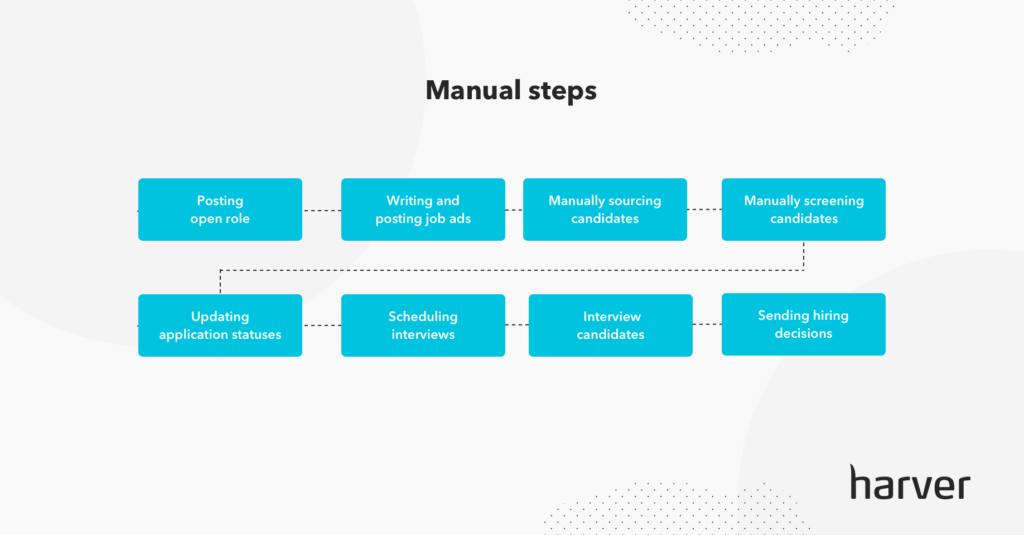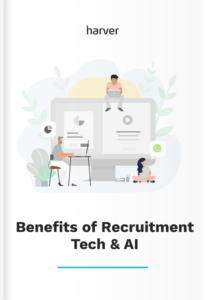The never-ending task of retail recruitment is often carried out by store managers. As well as the day-to-day tasks of managing their store and helping customers, most store managers also have to source, select, hire, and onboard new employees.
These admin tasks often come in the way of their day-to-day work, preventing location managers from focusing on what matters the most: driving revenue and keeping customers happy. To relieve store managers of manual recruitment tasks, you can automate certain elements of your candidate selection process to save both time and money, ensuring your hiring process is fast, efficient, and fair.
Before we delve into the tools and best practices to automate candidate selection in retail, let’s take a quick look at what the existing candidate selection process looks like.
What’s in?
What candidate selection in retail looks like
According to the National Retail Federation, employee turnover in retail stands at about 60%, more than 3 times the national average of all US industries (19%). This means that to meet demand, store managers are continually going through the motions of hiring and rehiring.
A typical manual candidate selection process in retail likely consists of the following stages: sourcing candidates, reviewing applications, screening applicants, scheduling interviews, checking references, carrying out interviews, making hiring decisions, sending job offers, and onboarding new hires.

In regular recruitment, all these steps can be carried out manually, but when you’re dealing with multi-location recruitment and hiring high volumes of employees on a regular basis, it’s simply not efficient to perform all these tasks manually.
Volume hiring retail recruiters can drastically improve the efficiency of their processes through automation. For example, Albert Heijn, one of the largest European supermarket chains with over 80,000 employees, reduced their time to hire by 40% and increased candidate satisfaction with the job application process by 87%, by automating most of the stages in their recruitment funnel.
Before digitizing these steps, tasks such as scanning CVs and scheduling interviews were taking time away from their core responsibilities and were driving the time to hire to 20 days on average. Candidates were also quickly losing interest and dropping out of the application process, so the entire experience was hurting the brand. After all, even rejected applicants today can be customers tomorrow.
You can read the case study below.
What stages of the candidate selection process should you automate?
In an ideal scenario, any stage that doesn’t require human input should be automated: from sourcing to screening and interview scheduling. In fact, the only time store managers should be involved in the hiring process at all is to conduct the interviews and make the hiring decision. That’s it.
Why should you automate these steps?
When you’re hiring at scale, store managers are reviewing and assessing hundreds of applicants each month. When implemented correctly, automation allows recruiters to make consistent, bias-free hiring decisions, removing variables that are not predictive for on the job success.
Automation doesn’t just benefit the store manager though, it benefits the applicants too, by delivering a streamlined application process that is fast and decreasing the time to hire from days to hours.
In the case of Albert Heijn, for example, store managers can see all of their candidate profiles, including skill sets and matching scores, on one platform. They can schedule interviews with the push of a button, and candidates receive instant notifications. Interviews are held within 24 hours of applying, which drastically reduces the overall time to hire.
In an industry like retail, where entry-level candidates are applying to multiple jobs at the same time, offering job security faster than a competitor can tilt the balance in your favor.
Like what you see?
Don’t miss out. Subscribe to our quarterly digest to get the latest TA and TM resources delivered right to your inbox.
Automating candidate selection: tools & best practices
1. Candidate sourcing
In high-volume recruitment, sourcing is often one of the biggest bottlenecks, especially when dealing with multiple locations where the supply and demand are out of balance.
Talent acquisition professionals spend on average one-third of their workweek finding the right candidates for their open roles and struggle with challenges such as incomplete profiles, thin resumes that don’t tell much about an applicant’s potential, and unanswered emails and phone calls. This can easily lead to recruiter burnout and is one of the causes behind the high rates of turnover affecting the recruitment function.
It’s therefore clear that automating candidate sourcing is beneficial and can help recruiters work more efficiently. But how can you automate this task, in practice? Let’s look at some tools and best practices.
Best practices
- Optimize your brand’s online presence. Your employer brand is key to attracting the right candidates in the first place. Check out your company reviews on Glassdoor. Evaluate both positive and negative reviews and take action to improve employee engagement where necessary.
- Use programmatic job advertising. Use automation to help you with programmatic job advertising – where you use software, rather than people, to purchase, place, publish and optimize your job ads. This means the whole web is your oyster, not just a few select job boards.
- Build a strong sourcing pipeline. Having a pool of high quality candidates already in your ATS is an essential recruitment strategy. From people who follow your social channels, to unsuccessful previous applicants, keep in touch with people (automatically) in case a suitable role comes up.
- Use a good ATS. 99% of Fortune 500 companies rely upon an ATS to help their recruitment process. From automatically filtering candidates during the first screen, to identifying top talent with the requisite skills, to storing unsuccessful applicants with different skills, ATS is essential to your hiring process.
- Analyze your sourcing data. Track of your metrics – where are most new hires coming from, what does turnover look like, which sources yield the best candidates. By keeping tabs on which channels are the most fruitful, allows you to increase your efforts there.
Software options
Hiretual is an AI powered candidate search and data engine designed to bolster your sourcing efforts. It integrates with your existing tech stack, giving you a complete top of the funnel solution, sourcing across 750+ million profiles, creating personalized campaigns and helping you rediscover lost candidate profiles in your ATS.
Fetcher’s all-in-one candidate sourcing software solution uses AI to give you an ‘internal team’ that trains and monitors your data, to ensure a steady supply of diverse, qualified and interested candidates. It aggregates up to date candidate information from across the internet, including professional and personal social networks, and automates repetitive tasks.
How AI & recruitment technology is changing recruiting experience
Find out how tech has helped other companies grow by enhancing both the recruiters’ and candidates’ experience!
2. Candidate rerouting
When you face the challenge of multi-location hiring, yet your organization’s hiring process is decentralized to individual store managers, it can mean candidates have to submit multiple resumes for the same position within your organization, for each individual store they want to work for.
This process bottleneck can be eliminated by automatically rerouting candidates between locations. For example, if you’re hiring for similar entry-level jobs at different locations in the same city, you can prompt candidates to apply to all locations during the application process, by showing them the available locations and the likelihood to get hired, based on supply and demand data.
Automating this step not only helps candidates get job security faster, but it also enables your talent acquisition team to collaborate better and use the talent pool more efficiently. Everyone has access to the talent pool and can contact candidates if they have too little supply.
Best practices
- Hire employees who are able (and keen) to work in multiple locations, not just in one store. This makes it much easier to staff a new store when required, rather than have to recruit from scratch each time.
- Gauge candidate interest in working in another location and reroute strong candidates to open roles in other stores in your organization to keep them in your company.
- Having a rerouting strategy in place allows you to highlight other open options less strong candidates are better suited to, potentially in other locations. This builds trust with the applicant and improves the chances of hiring them within your organization.
Software options
Harver, the leading retail candidate selection platform, is designed to help you hire better talent, faster. After successful assessment, our retail recruitment software allows applicants to select the various locations they would be interested in working at, instead of having to submit multiple applications to each store manager.
We’ve detailed the rerouting feature in the article below.
3. Screening & assessment
Moving on to the next stage of the recruitment process that can and should be automated: candidate screening. Job posts for entry-level roles such as the ones in retail can receive more than 250 applicants, and aiming to screen all of them manually means not only a lengthy and inefficient process, but also lost candidates.
Automating screening means that instead of going through resumes one by one and analyzing the education, work experience and skill set of each candidate to see if they fit the job description, recruiters can set selection criteria in their hiring platform, and let tech to the rest of the work.
If the open roles require specific skills, the exact combination of skills that predicts success on the job can be assessed through a mix of pre-employment assessments, such as personality questionnaires, situational judgement tests, or multi-tasking assessments.
Best practices
- Create a benchmark. In order to assess candidates effectively, you need to determine what a high quality employee looks like in your organization. Perhaps they’re incredibly conscientious, or they have multitasking abilities, use this as a benchmark to screen and score applicants against.
- Pre-employment assessments. Accurately assess an applicant’s skills, character traits and abilities through situational judgement tests, while they’re experiencing a realistic job preview. If the applicant doesn’t like what they see, they can self select out of your hiring process.
- Video interviewing. This can provide more context than a phone interview. Send successful candidates a list of predetermined questions for them to record answers to and send back. Use an AI tool such as MyInterview to evaluate their answers, progressing successful candidates to in-person interviews.
Software options
Harver
Harver optimizes candidate screening and evaluates applicants through AI-powered, scientifically-validated pre employment assessments. We use data and science to predict the quality of hire by measuring a candidate’s aptitude, fit, skills and ability.
We do this by building fully customizable assessments, bespoke to your retail organization, that focus on skills and mutual fit, rather than job types. Our two-way talent matching framework, coupled with automation, enables you to create engaging and informative candidate experiences, while ensuring that you’re selecting the best candidates for your open roles.
You can read more about our technology and candidate selection framework in the article below.
Ideal is an AI driven resume screening tool and matching talent tool that helps enterprise teams make better, faster, fairer hiring decisions. It instantly screens hundreds, even thousands of applicants, in real time, leaving you with an accurate, unbiased shortlist to move forward to interview.
4. Showcasing your company culture
One of the main reasons for the high employee attrition rates in retail is misaligned expectations. I.e. what the candidate thought the role would be, what they thought your culture would be, what they thought the work environment would be, don’t match up to the reality of the job.
To counter this problem, you can embed videos showcasing your culture throughout the application process, so candidates can hear directly from employees in the role they’re applying for, telling them what they’re getting into.
Also, you can use realistic job previews (RJPs) to showcase the realities of the role, the work environment, including some real life scenarios employees regularly encounter such as angry customers or questions about stock. You can combine RJPs with other pre-employment tests to assess applicants for particular skills while providing them a taster of what life is like working for you.
Best practices
- Social media. Ensure your social platforms are an extension of your brand. Keep copy, TOV and messaging consistent across all your channels. Use tools like Hootsuite to automate scheduling and posting to your accounts.
- Video marketing. Embed videos in your careers page, such as different employees discussing different aspects of the job, what the company values mean to them, or what they most enjoy about working in their store.
Software options
Harver
The Harver platform offers a series of modules that can be used for assessing the cultural fit, as well as showcasing the company culture and work environment. Recruiters can choose to display company videos throughout the application process and to incorporate tests that measure candidates’ preferences. You can check the modules below.
Textio is a great tool to help showcase your brand. It uses big data and machine learning to enable you to optimize your brand’s language and attract top talent to your open roles, by creating copy that will resonate with your target audience while reducing the instances of bias in the language.
5. Recruitment stage progression
From sending automatic messages informing qualified candidates they’ve progressed to the next stage, to allowing candidates to self schedule and interview, automating progression frees up store managers AND allows you to identify and engage with top talent fast and efficiently, hiring them before anyone else gets the chance.
Best practices
- Focus on quality. Clearly define what quality candidates look like, identify them and progress them through your funnel. Attract great candidates in the first place by promoting your company and sharing why it’s so great to work there. Use a referral scheme to encourage employees to refer prospective friends or colleagues they think would be a good fit.
- Assess for skills. Past performance is not an indicator of future success. Candidates looking to fill your entry level roles might be entering the job market for the first time, or might be transitioning from a different industry, in which case, they won’t have previous experience. But they could have the customer service skills you need, the problem solving ability, the ability to multitask, conflict resolution skills, for example.
Software options
Harver
Harver integrates with your existing ATS to automate stage progression, cutting your time to hire in half. Instead of having to manually check the assessment scores for each candidate and switch between multiple HR tools to move candidates to the next step of the process, you can automate this step and set specific criteria, depending on how loose or tight the market is.
Humanly automates stage progression, specifically screening and scheduling candidates in a DEI friendly fashion, while focusing on diversity hiring.
- White paper
Before you continue!
Don’t forget to grab your free copy of our new white paper on the digital transformation of retail volume hiring. Learn about:
- The challenges currently shaping the retail volume hiring space
- How to align your recruitment strategy with today’s reality by adopting technology
- The four building blocks of a fully digital recruitment process

6. Interview scheduling
In high volume recruiting, it’s common for candidates to ghost recruiters and to not show up to the interview or even worse, after accepting the job offer. This time consuming step of the candidate selection process should therefore be automated to avoid wasting time with candidates who aren’t a good fit. This way, recruiters can focus on what’s most important: the actual interviews and the hiring decisions.
Best practices
- Train interviewers. To ensure consistency and fair hiring, train interviewers in how to interview and give them a standardized list of questions that you ask of every candidate.
- Leave a buffer. It’s exhausting going from back to back meetings, so give yourself a break between interviews to regroup and refocus. Give each applicant your full attention.
- Follow up. Afterwards, capture all candidates’ feedback on your application process and the interview. You can’t improve the process if you don’t know where you’re lacking.
Software options
Harver
Harver takes the hassle out of scheduling candidates for an interview by automating it, saving store managers from having to do it, streamlining the process.
Our platform enables qualified candidates to self schedule interviews with store managers at a time to suit them, based on the store manager’s pre-determined availability, negating the endless back and forth emails, trying to find a time to suit you both.
If you’d like to learn more about this feature, you can book a demo below.
If you’d like to see how Haver can transform your hiring process,
book a demo here!
While Calendly isn’t built for volume hiring, which is a drawback when hiring at scale, it is still a good tool for allowing candidates to self schedule interviews. Simply highlight where you’re free in your calendar, and Calendly presents these openings to candidates to choose which time suits them for an interview.
Next steps
Automating candidate selection in retail recruiting enhances the experience for store managers and candidates alike. Automation technology is designed to free store managers from tedious, manual tasks, only requiring them to look in when a hiring decision has to be made.
If you’d like to see how automation works in the Harver platform, you can book a demo below.
Ready to transform your hiring process?




